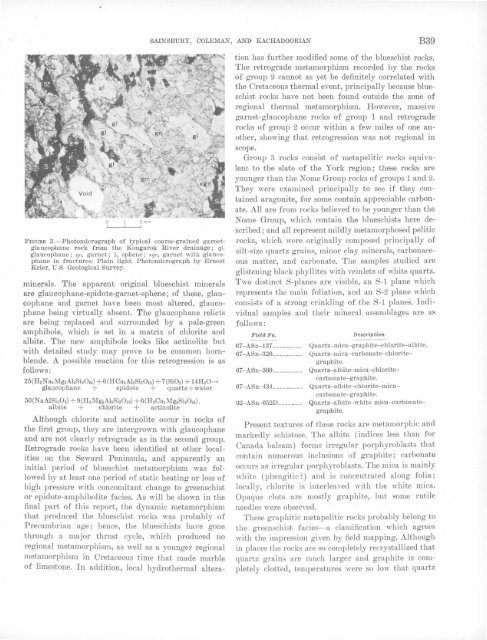RESEARCH· ·1970·
RESEARCH· ·1970·
RESEARCH· ·1970·
You also want an ePaper? Increase the reach of your titles
YUMPU automatically turns print PDFs into web optimized ePapers that Google loves.
0 2 mm<br />
FIGURE 3.-Photomicrograph of typical coarse-grained garnetglaucophane<br />
rock from the Kougarok River drainage; gl,<br />
glaucophane; gn, garnet; S, sphene ; xgn, garnet with glaucophane<br />
in fractures. Plain light. Photomicrograph by Ernest<br />
Krier, U.S. Geological Survey.<br />
minerals. The apparent original blueschist minerals<br />
are glaucophane-epidote-garnet-sphene; of these, glaucophane<br />
and garnet have been most altered, glaucophane<br />
being virtually absent. The glaucophane relicts<br />
are being replaced and surrounded by a pale-green<br />
amphibole, which is set in a matrix of chlorite and<br />
albite. The new amphibole looks like actinolite but<br />
with detailed study may prove to be common hornblende.<br />
A possible reaction for this retrogression is as<br />
follows:<br />
25(H2Na2MgaAhSis024) +6(HCa2AlaSiaO,a) +7(Si02) + 14H20-><br />
glaucophane + epidote + quartz+water<br />
50(N aAISiaOs) + 9(HsMgsA12SiaO,s) + 6(H2Ca2MgsSis02t).<br />
albite + chlorite + actinolite<br />
SAINSBURY, COLEMAN, AND KACHADOORIAN<br />
B39<br />
Although chlorite and actinolite occur in rocks of<br />
the first group, they are intergrown with glaucophane<br />
and are not clearly retrograde as in the second group.<br />
Retrograde rocks have been identified at other localities<br />
on the Seward Peninsula, and apparently an<br />
initial period of blueschist metamorphism was followed<br />
by at least one period of static heating or loss of<br />
high pressure with concomitant change to greenschist<br />
or epidote-amphibolite facies. As will be shown in the<br />
final part of this report, the dynamic metamorphism<br />
that produced the blueschist rocks was probably of<br />
Precambrian age; hence, the blueschists have gone<br />
through a major thrust cycle, which produced no<br />
regional metamorphism, as well as a younger regional<br />
metamorphism in Cretaceous time that made marble<br />
of limestone. In addition, local hydrothermal alteration<br />
has further modified some of the blueschist rocks.<br />
The retrograde metamorphism recorded by the rocks<br />
of group 2 ca1mot as yet be definitely correlated with<br />
the Cretaceous thermal event, principally because blueschist<br />
rocks have not been found outside the zone of<br />
regional thermal metamorphism. However, massive<br />
garnet-glaucophane rocks of group 1 and retrograde<br />
rocks of group 2 occur within a few miles of one another,<br />
showing that retrogression was not regional in<br />
scope.<br />
Group 3 rocks consist of metapelitic rocks equivalent<br />
to the slate of the York region; these rocks wre<br />
younger than the N orne Group rocks of groups 1 and 2.<br />
They were examined principally to see if they contained<br />
aragonite, for some contain appreciable carbonate.<br />
All are from rocks believed to be younger than the<br />
Nome Group, which contain the blueschists here described;<br />
and all represent mildly metamorphosed pelitic<br />
rocks, which were originally composed principally of<br />
silt-size quartz grains, minor clay minerals, carbonaceous<br />
matter, and carbonate. The samples studied are<br />
glistening black phyllites with veinlets of white quartz.<br />
Two distinct S-planes are visible, an S-1 plane which<br />
represents the main foliation, and an S-2 plane which<br />
consists of a strong crinkling of the S-1 planes. Individual<br />
samples and their mineral assemblages are as<br />
follows:<br />
Field No.<br />
Description<br />
67 -.A
















